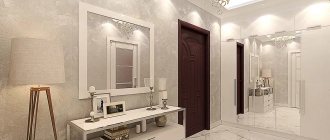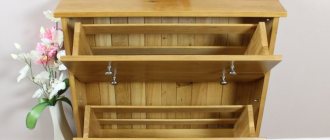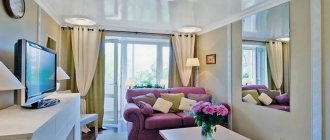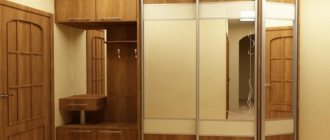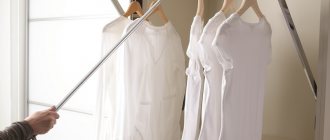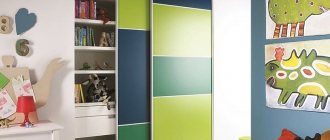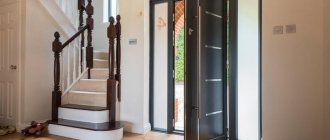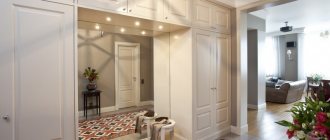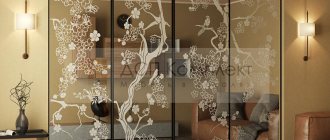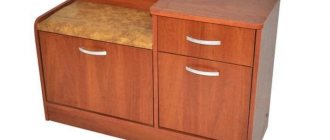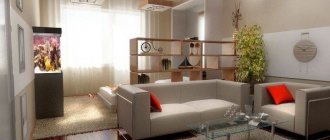Advantages and disadvantages of built-in wardrobes
Built-in furniture has many advantages:
- significant space savings due to sliding doors;
- due to the fact that the back and side walls do not need to be made, an order of magnitude less material is spent, which significantly reduces the cost of the finished product;
- the ability to neatly fit the element anywhere in the apartment;
- with similar dimensions, greater capacity than a free-standing piece of furniture;
- variety of design options;
- internal content is created to suit the needs of a specific person or family;
- the widest selection of manufacturing materials and design;
- almost unlimited functionality;
- behind the surfaces of the structure it is easy to hide unsightly interior details - pipes, meters, columns, ventilation ducts, etc.
But there are also a number of disadvantages:
- In order for a piece of furniture to look beautiful and not have any distortions, the place where it is planned to be built must have smooth walls, a floor, and all angles must be strictly 90 degrees;
- when installing in a room where suspended ceilings are planned, additional guide beams for doors will be required;
- when moving, you won’t be able to take the product with you; during redevelopment, you won’t be able to move it to another corner;
- A poorly made sliding door system can quickly fail, which will entail additional material and time costs.
How to decorate a narrow hallway in an apartment?
When making renovations indoors, it is best to mount a suspended ceiling with high-quality lighting that provides good lighting. Materials used for wall decoration must be washed well. Floors are also made practical; they will have to be washed frequently, so the coating must be resistant to moisture and abrasion. There must be sufficient passage between objects for ease of movement. The space needs to be arranged in such a way as to maintain the existing width. For work it is worth purchasing modern high-quality materials.
Your home begins with the hallway, so you need to pay attention to it and make it as attractive as possible. Minimalism is often used for its design. When creating a modern room, you need to go through the following stages:
- Development of the project taking into account all wishes. You need to take all the necessary measurements to select furniture.
- You can develop a design project yourself or order the services of a professional designer.
- Furniture should be made to order or purchased to suit your measurements. It is important not to overload the space. You can choose narrow hallways in the corridor or give preference to an open hanger.
- The choice of finishing materials should be made in specialized retail outlets. Buy practical, easy-to-clean building materials.
Hallway Henri
Types of sliding wardrobes
Built-in wardrobes of the “compartment” type are made to order, in accordance with the size and configuration of the room. They are distinguished according to the following parameters:
- installation location;
- mounting method;
- material of manufacture;
- purpose;
- type of assembly;
- design features;
- design design;
- number of doors.
The door opening mechanism can be supported or hinged. The support version is reliable, able to withstand heavy loads, in the lower part there are rollers on which the door moves. In the hinged version, the rollers are on top - the door here should be as light as possible.
According to model design
The designs of sliding wardrobes are different:
- linear - the product is placed along one wall, adjacent to one corner or significantly short of it, built into a niche (two corners are involved here), can be trapezoidal;
- corner - can be L-shaped, that is, consisting of two cabinets connected together, triangular, pentagonal - having side shelves;
- radius - mounted in a corner, less often - to one wall, the front part is made round - convex or concave. The product is difficult to manufacture and install, so the costs for it will be slightly higher than for simpler options;
- combined - such a structure looks like a wave, it is quite large, it is installed in spacious rooms, decorating them.
By number of doors
The number of doors is calculated based on the size of the structure. The fewer doors, the easier and more convenient it is to use the locker. The standard width of the doors is 55-75 cm. The overlap of sliding doors is at least five to seven cm. The most popular are two-door cabinet designs - the doors are made sliding or hinged. Single door ideas are items that are partially open or have only one door that opens. In a three-door cabinet, as well as products with a large number of doors, the number of vertical compartments is made one for each door.
By installation method
The compartments are mounted in various ways, which determine the technical characteristics of the finished structure:
- built-in - has no side walls, lid or floor, instead of all this - the main surfaces of the room. The space here is used to maximum advantage. The product is built into a niche that is completely covered by a facade with doors - there should be no gaps;
- semi-built-in - installed along the wall or in a corner, has one or two sidewalls, the “insides” of such a cabinet are mounted directly on the main or interior wall. The structure provides additional sound insulation for the room located behind it;
- suspended - the design creates the impression of doors “floating” in the air, the sliding mechanism of which is not visible;
- floor - refers to cabinet furniture, stands on the floor, does not reach the ceiling a little, and is not attached to the walls of the room.
Creating a niche in the hallway
A small hallway in a niche made of plasterboard is an excellent solution for a small house. It will save precious meters, add zest to the style, and hide wall defects.
Features of arranging a niche in the hallway yourself:
- Creation of project documentation.
- Marking.
- Installation of the frame, as well as attaching drywall.
Accommodation options
The built-in product provides an excellent opportunity to make the most of every centimeter of available space. The project indicates where the future furniture product is planned to be built. In a cramped “Khrushchev” building this is usually a niche, in more spacious “Stalin” buildings it is a long, wide corridor to which such a product will add comfort. If the room is large, there are several lockers designed for different purposes.
In "Khrushchev"
Khrushchev's apartments are characterized by cramped front rooms with relatively low ceilings - about 240 cm. The built-in closet here is quite small, decorated very minimalistically. The product is narrow, small-sized, the available space is slightly expanded with the help of mirror surfaces, open shelves, decorative and functional lighting.
The wardrobe in Khrushchev-era apartment buildings often has a solid or separately mounted extension in the form of mezzanines located at an angle or opposite the main structure. Both parts are combined with each other in design and color scheme.
In a long narrow hallway
A long narrow corridor is decorated with a cabinet of smaller width than usual. Hinged doors are undesirable here - they clutter up a tight space, interfering with movement. Clothes on hangers in such a cabinet are placed on rods along the door, the shelves are also narrow - up to 40 cm. It is also better to avoid voluminous decor, but large mirrors will fit the theme.
In a small hallway
For small front rooms, narrow, short cabinets are selected. Case structures are unacceptable here, as they take up a lot of space. To visually expand the space, light glossy surfaces and full-length mirrors are used here. Bright, multi-colored, overly detailed ornaments are not suitable - they look bad in a cramped room.
In the large hallway
The spacious front room is decorated with a large wardrobe. When the shape of the room approaches a square, it is permissible to install two symmetrical corner structures. This makes sense if a large family lives in the apartment and has a lot of things. Clothes and shoes are stored here in one corner, and various household utensils, sports equipment, small household appliances, etc. are stored in the other. An L-shaped or radius cabinet is also acceptable. The latter is conveniently located between two doors leading to separate rooms. The case design is also suitable. Advice: when the hallway area is 10-15 or more square meters, it is easy to arrange a full-fledged corner wardrobe.
Making the hallway bigger
In front of you is a typical hallway in a modern panel house: a narrow, unpretentious room that desperately lacks light. Meanwhile, there are many ways to visually increase space - it’s a pity that many owners do not resort to them as often as they would like.
In this example, we also note the tiny size of the hallway, which has already become the norm in a panel house. The choice of color is completely justified: light colors help to somewhat deceive our perception and visually enlarge the room.
Mirror surfaces not only elegantly decorate the hallway, but also significantly expand its boundaries. It is especially beneficial from the point of view of optimizing space in a small room to place them on built-in wardrobes.
Another common way is to play with contrasts. The use of shades of diametrically opposite temperatures helps relieve the room from excessive compression, and also adds gloss and attractiveness to the design.
If the size of the room is restrictive, it is important to choose the right basic color scheme. So as not to make things worse. The photo shows a rather cozy hallway with a special, homely feel. The owners chose the wallpaper correctly, preferring a distinctly light beige tone to some fashionable photo wallpaper in the hallway.
Massive mirror panels visually make the hallway wider - we already noted this above. Let's add a little to this design rule, as old as the world: in combination with light wall design and matching furniture, the maximum effect of expanding a cramped and narrow space is achieved.
Keep your shoes in order - make a shelf for them yourself or buy them in a store. The benefit from it will be significant, because sloppily scattered boots, sneakers, shoes, and even things simply placed on the floor tend to hide free space.
Floor tiles laid diagonally are also among the main and effective ways to expand a narrow space.
Avoid bright wallpaper with large patterns. Of course, the design of the hallway in your panel house cannot be limited by strict boundaries, which will kill originality in the bud, but it’s worth keeping this unspoken rule in mind.
Wardrobe design
The external design of the structure is selected according to the design of the room:
- classic - only natural light wood, a small number of carved elements;
- hi-tech - frosted glass, shiny metal, an abundance of mirrors, doors are made only sliding;
- loft – artificially aged wood with “artistic” abrasions;
- Japanese – glass with photo printing on an oriental theme, bamboo parts;
- minimalism – special strong plastic, plain glass, MDF;
- environmental – wood, chipboard, color imitating untreated wood;
- Baroque - predominantly dark wood, decorated with carvings, hand painting, mosaics;
- Provence - painted chipboard, wood decorated with decoupage, hinged doors.
Materials - pros, cons
The manufacturing materials used here are almost the same as for creating a regular cabinet:
- natural wood;
- MDF;
- chipboard;
- Fiberboard;
- plastic;
- drywall;
- metal.
The frame is most often made of metal or wood - it must have increased strength. Plastic is often used for external decoration due to its low cost, but it is easily scratched, losing its appearance.
When planning the internal content, take into account that shelves and other elements should not be excessively thick, wide, or take up a lot of space.
Sliding wardrobe made of chipboard
The most popular is the creation of furniture from chipboards - the material is inexpensive, durable, easy to process, but heavy and unattractive without special finishing. Its main disadvantage is the presence of formaldehyde in its composition, which, to a greater or lesser extent, can be released into the environment, therefore such cabinets are not recommended for installation in apartments where children live. The structure is decorated with mirrors, including those with sandblasted painting on the edges or corners, colored glass, self-adhesive films imitating the texture of wood, stone, etc.
MDF sliding wardrobe
Lining made of MDF and plastic is also used, but the door frame is made of wood for strength. The product has a beautiful appearance; the outside is decorated with matte or glossy PVC film, valuable wood veneer, or painted. The design is affordable, strong, durable, does not emit harmful formaldehydes or benzenes into the environment, and is easy to install. A variety of colors allows you to choose an MDF cabinet to suit almost any interior. A significant drawback is the rapid ignition of the material upon contact with an open fire. Tip: the facades of MDF structures are decorated with mirrors, glass with photo printing and a sandblasted pattern. There are options that externally imitate the texture of wood.
Wooden wardrobe
Wooden construction is an indispensable attribute of a stylish, luxurious interior. Natural wood is more expensive than other lumber, but the appearance of a product made from it is very different from cheaper imitations. The material is strong, wear-resistant, durable, pleasant to the touch, and does not emit harmful chemicals into the air. The following types of wood are commonly used:
- stained, bleached oak;
- beech;
- hornbeam;
- larch;
- nut;
- Linden;
- pine;
- ash;
- cherry;
- maple;
- birch.
Expensive woods such as mahogany, cedar, wenge are used only for decorating luxury interiors. More often they are found in high-quality imitation, which only a specialist can determine, as well as veneer finishing.
It is important to choose wood without knots, cracks, and with a minimum amount of twists. Typically, glued laminated timber or lining is used; it is advisable to treat them with special compounds that prevent molding, damage by fungus, and insects. This is especially important for apartments located on the ground floor, where there is constant dampness.
Sliding wardrobe made of plasterboard
A structure made from plasterboard sheets is not a locker in the usual sense, but rather a part of the house itself. Most often they make it with their own hands, less often they order it to be made by a craftsman. The product is cheaper than a structure made of chipboard, it will become an excellent zoning element of the interior - it can easily fit into any room, despite the existing design of the latter. This cabinet is quite durable and can withstand significant loads. The disadvantage of the product is that it is impossible to make the cabinet mobile - only stationary. Sharp objects and piercing and cutting instruments cannot be stored in it, nor can heavy doors be hung on hinges. If “classic” doors are necessary, the structure is additionally reinforced with wooden blocks and additional profiles.
Choosing the right finish
It’s hard to go wrong by calling wallpaper the most common finishing material for the walls of a modern hallway in a panel house. A remarkable fact: in an era of dominance of provocative designs and flashy tones, the good old classics continue to retain their charm and relevance.
In a dispute with ceramic tiles, even if laminate does not win, it continues to maintain stable parity. Its main advantages are ease of installation, good imitation of wood species, and high tactile comfort.
The combination of decorative plaster and classic wallpaper is found quite often in city apartments. Hallways decorated in this way radiate comfort and tranquility.
It’s quite possible to do without artificial stone in the hallway, but why, if it’s really better with it? This finishing material can be used both to decorate the entire wall of the room, and partially - in order to emphasize certain accents in the design.
Materials for doors, facade
In order for the finished structure to have a presentable appearance, you need to take care of the quality of the doors and facades. They are made from:
- wood;
- chipboard;
- MDF;
- HDF;
- acrylic;
- lakomat;
- lakobel;
- glass;
- mirrors;
- plywood.
The type of materials from which these elements will be created, decorative design, is selected in accordance with the planned or existing interior style. For classic, ecological, Provence, Baroque, and loft styles, natural wood is preferred. Mirror surfaces are most often used in high-tech and minimalist styles; MDF is used in both classical and modernist interiors.
For fashionable decoration the following are used:
- sandblasting drawings on glass;
- vinyl;
- rattan;
- leather;
- Cork tree;
- applied carved wooden parts;
- photo printing;
- stained glass;
- silkscreen printing.
Combined products look best: wood and glass, MDF and mirror inserts, lacobel and chipboard.
Modern Design Ideas
The interior in a classic style is decorated in neutral colors such as beige, peach, milky tones, blue, pink or light green. An additional decoration for the classic interior of the hallway are lamps or other objects with forged parts in gold or bronze. The decoration and furniture are made only from natural materials, which involves quite expensive repairs.
In the photo, a mirrored door to the hallway in a modern style visually enlarges the space and makes the overall design more harmonious.
Cladding in the loft style, combining concrete, plaster, stone, wood and urban details, enlivens the interior of the corridor in Khrushchev and gives the atmosphere dynamism. The room is supposed to be installed with simple plastic or wooden furniture without fancy decorative elements. A chest of drawers or shelves, complemented by pendant lamps and lamps, will fit perfectly into a small room.
The photo shows a white and beige hallway in a classic style with a wooden cabinet.
Dimensions
The dimensions of the cabinet can be made to almost any size – it all depends on the parameters of the existing room. The design should look good, accommodate everything you need, without cluttering the room. The height is usually made up to the ceiling, less often it does not reach it by 10-20 cm, the depth is 40-100 cm, but the corner models are deeper, the average length is 0.8-3.2 meters.
If it is planned that the locker will be used by several people, then the item is made even larger. For children and small adults, a small step-stand should be provided.
Options for arranging a closet in the hallway
Regardless of the size of the hallway, it is extremely important to arrange it correctly. For most rooms, the best option is a built-in corner wardrobe. If space allows, as in a private home, you can, in addition to it, place a separate open hanger for frequently used clothes and shoes.
In the interior of a spacious hallway, radius cabinets with glass fronts look very presentable
In a small hallway, a compact built-in wardrobe with sliding doors would be appropriate.
It is better to place furniture as close to the entrance as possible in order to be able to quickly take off and put on clothes. Also, for this area it is worth providing a floor covering that will be easy to clean, but will not allow garbage to easily spread throughout the apartment. For example, it could be a combination of ceramic tiles and a stain-resistant mat.
Models built into a wall niche look compact and neat
The wardrobe in the hallway is the central element of the interior, setting the tone not only for this room, but also forming the overall impression of the entire apartment. Therefore, choosing the right one will allow you to create exactly the atmosphere that you want to maintain in your home.
Internal structure, cabinet filling
The internal content depends on the purpose of the product - only for clothing, clothes and shoes, household items and toys. The standard “filling” is something like this:
- spacious sections for storing large items with significant weight;
- the shelves are of different sizes, the distance between them is also very different;
- drawers that slide out. They store underwear and other small items;
- rods where wrinkled and outerwear are hung;
- umbrella stands;
- tie hooks, etc.
On the upper level, in drawers or on shelves, things that are rarely used are located; what is needed daily is kept closer.
Pantographs, crossbars, rods
These items are usually made of strong hollow pipes and are intended for placing various items of clothing on hangers, hangers of various configurations - coats, blouses, trousers, skirts, etc. A regular rod or several are mounted in cabinets with a width of 65 cm - this distance is quite enough, to hang hangers without impeding the movement of sliding doors.
Pantographs are mounted at a great height - the object is convenient in that it can be easily lowered if necessary, and then put in place without resorting to the help of stepladders, stools, or steps. Trouser hangers are the most convenient device for all family members, usually located in the lower side of cabinets. They are a small structure with several parallel thin crossbars located at a short distance from each other. Hangers for belts, sashes, ties, bras, and other similar items are mounted on one of the side walls, significantly saving space. Such items can be hung on hooks, which is less convenient.
Combined rods are purchased for corner structures. In them, the long part is used for hanging fur coats, coats, long raincoats; on the short upper section, children's outerwear, jackets, jackets are placed. Umbrellas and bags are located below. Hangers mounted perpendicular to the wall are suitable for narrow cabinets - up to 45 cm; retractable hanger structures are also placed there.
The upper rod is mounted at a height of 100-150 cm, the lower – 60-85 cm. Pantographs are placed even higher.
Drawers, laundry baskets
There can be quite a lot of boxes - to determine what is in each of them, a sticker with a corresponding image or inscription is pasted onto the visible part. Baskets are usually mesh or wicker, made of plastic, metal, rattan, etc. Hosiery, underwear, neck scarves, head scarves, and various knitwear are stored here. Hats are also placed in boxes.
Shelves, niches for storing shoes
Shoe racks vary in height: in some it is convenient to store sneakers, sneakers, flip-flops, in others - over-the-knee boots, high-heeled ankle boots, ankle boots, etc. Boots are sometimes placed on special hangers with clothespins. Boxes, boxes, baskets with shoes are usually stored on the shelves below. The exception is holiday, “weekend” shoes, worn literally a couple of times a year - they are stored right up to the ceiling.
If a large built-in wardrobe is the only such item in the apartment, blankets, bed linen, spare pillows, and blankets are stored here on the upper shelves. This is only permissible in cases where these items cannot be hidden in the bedroom.
Updating old furniture: where to start
Most often, the renovation process affects only the front part of the cabinet. The doors are repainted, covered with wallpaper and decorative film.
All these measures give a temporary effect if you do not approach the process thoroughly. Defects in the coating do not go away: chips, smudges of old paint, and unevenness are visible under the next layer of such decor.
It’s best to start updating an old built-in wooden wardrobe by carefully dismantling the hinged doors. Based on their condition, you can now determine whether it is worth working with this material or whether it is better to make new blanks of similar sizes from laminated chipboard or plywood.
If you decide to leave the old doors of the built-in wardrobe, then you need to carefully sand them, putty all the irregularities, dents and traces of old fasteners, and level the ends.
You need to do the same with the door frame: remove layers of the previous paint, sand it, fill up holes and dents.
After complete drying, the door frame can be painted in the chosen color. But you can still think about how to decorate the doors of an old closet so that they organically fit into the overall interior of the hallway and decorate it.
Features of self-installation
To install the structure yourself, you will need various tools and fasteners:
- dowels, screws;
- double sided tape;
- sliding mechanisms for doors;
- guides;
- friezes for guides;
- alcohol wipes to degrease the surface (you can use vodka and a gauze swab);
- mounting metal corners of different sizes;
- rods and rod holders;
- hanging racks;
- building level, at least a meter long;
- tape measure or electronic rangefinder;
- jigsaw;
- screwdriver;
- hammer;
- screwdrivers;
- electric drill or hammer drill;
- various accessories for external decoration.
The most important thing here is to correctly measure all the parts, calculating the allowances for mounting (the excess can be trimmed later), and take into account all the errors of the walls, if it is impossible to properly align them. Measurements are taken at three levels in the rear area (top, bottom, middle), after which the future frontal plane and sidewalls are measured. At least 9-12 cm is laid on the sliding door mechanism; it is attached to the frame and guides. Long shelves, more than 700-900 mm, are attached at three or four points; dowels are used for cross-shaped storage devices, and additionally PVA glue is used. Lattice structures are mounted on furniture clips, corner ones - on a vertical bar.
The upper and lower guides must be strictly parallel - if this point is not observed, there may be problems with the movement of the doors, even to the point of them falling out of the cabinet.
Rules for choosing a finished cabinet
Some companies offer built-in structures of standard sizes - usually such products are mounted in a corner, since niches come in completely different sizes and choosing a suitable cabinet there is problematic. In stores, cabinets are selected according to the samples provided.
Advantages of purchasing a ready-made built-in item:
- you don’t have to wait – the cabinet is already ready, all you have to do is take it home and install it. When ordering a product based on an individual project, you will have to wait several weeks;
- what the finished coupe looks like, how its doors close and open, what kind of shelves, rods, hangers, niches there are, possible defects are immediately visible;
- lower cost than custom-made designs. The price excludes the visit of a measurer or designer, since this is a standard product.
But there are also disadvantages:
- a cabinet structure will take up more space than a fully built-in one, which is very significant when the hallway is small;
- color, configuration, finishing, decor will have to be chosen from the proposals - for complex interiors this option is unacceptable.
When choosing, you should take into account the compliance of the internal content with the intended tasks. Door closers must be of high quality - the ease of use of the entire product depends on their performance. If the cabinet is equipped with mirrors, it is advisable to have a protective film on their surface - if accidentally broken, it will prevent small fragments from flying around the room and injuring any household members. The design is also taken into account - the cabinet must match the design of the room for which it is intended.
Photos of interior hallway closet design ideas
To better imagine how models of different styles and shapes look, you should familiarize yourself with photos of designs for ideas for built-in wardrobes in the hallway.
How to make it yourself
Making a full-fledged wardrobe with your own hands is quite difficult - you will need to carefully measure all the corners, cut the material, and think through the sliding system.
What exactly needs to be done:
- decide what exactly will be placed inside the product;
- make all necessary measurements;
- prepare a corner, niche, wall;
- draw a sketch, and then a drawing, indicating all dimensions;
- think over the design of moving parts;
- choose a method for securing shelves, rods, drawers;
- buy all the necessary materials, tools, accessories;
- cut out the planned parts;
- completely assemble the structure;
- if necessary, paint and varnish;
- if you wish, install internal lamps.
Width, depth, number of doors are designed based on the size of the room. You can order cutting of parts at a carpentry workshop - at home this is very problematic. There you can additionally pay for the edging of all cuts, which will protect the finished product from possible exposure to moisture, increasing its service life.
